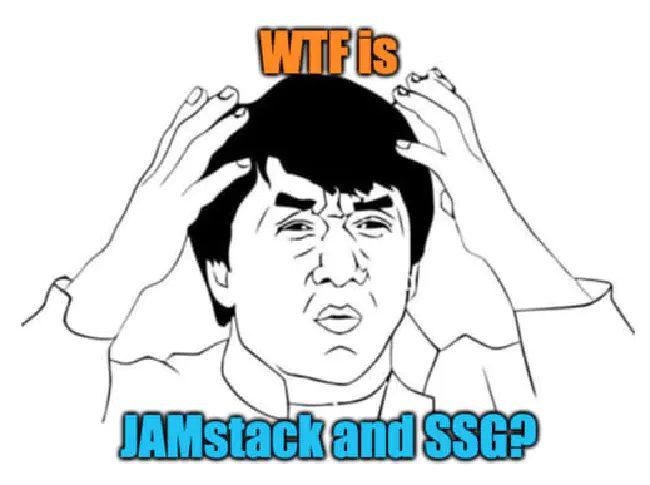Introduction
Update (03/05/23): The Headless CMS landscape has changed massively in the 5 years since this article was originally written. We revised it in 2021 but now both Forestry and NetlifyCMS are no more. So we felt that it was time for a refresh. You can find our most recent article about the best Jamstack CMS this year as well as some alternatives to Forestry
Even though we can’t say that JAMstack is the most popular choice amongst developers nowadays, it’s got a bright future ahead. This new architecture mixes up the best that dynamic sites have to offer without compromising the good old static site values we all love. Its scalability makes it very easy to work with, as you can choose your entire front-end side and organize it as per your design. Of course, we can’t forget that JAMstack and static sites are highly secure and much faster than the dynamic types. JAMstack is built with the help of JavaScript, APIs, and Markup, but if you want to focus on your website’s front-end, you’ll have to add some CMS as well.
What is CMS?
CMS is short for Content Management System. More than half of all websites need a CMS to function. That’s because not everyone who wants their own website knows how to code. And even if you do, using a CMS is so much easier and faster. A good CMS lets you customize your website to your heart’s content.
Traditional CMS is built with back-end and front-end. However, that won’t work for JAMstack. That’s why we would like to introduce headless CMS. Headless basically means a CMS without the front-end. As you’d imagine, this leaves plenty of room for imagination. But it also does wonders in functionality. Being headless, a CMS will be able to repurpose content and use multiple front-ends.
Some types of CMS for JAMstack
Choosing the perfect CMS for your own needs is easy once you’re properly informed. That’s why we have gathered the best CMS choices and set out to introduce them to you in this article.
1. Forestry.io
The first CMS we’d like to recommend is Forestry.io. Unlike other CMS, Forestry.io is Git-backed and uses static state generators for building websites. Forestry.io connects developers and their teams and makes developing interesting and easy. Using Forestry.io for building a static state website comes with many advantages. Static sites are easy to set up, and you won’t have to configure a complex server. It means the entire process will be faster, cheaper, and hassle-free. Besides, your sites will handle a lot of traffic and will be less vulnerable to hacking.
When it comes to deployment, Forestry is surely a winner among other traditional CMS. To put it simply, you can edit your website at any time locally. You can push to Git and have your changes deployed to production. In this case, developers and editors will work together with Git and will be able to deliver efficiently. This wasn’t possible in the past when developers and editors had a separate workflow.
Forestry will work best with sites built with Hugo or Jekyll. Of course, there are many go-to tools for developers, but Forestry proved to be the most convenient. It is completely free for personal projects but if you choose some premium packages, you will get more benefits such as importing to a large number of sites, premium support, ongoing training for your editors, and many others.
Forestry is currently in the process of moving to tina.io, a CMS that supports react. We will be writing a report on it so watch this space.
2. Ghost
Ghost is an open-source platform aimed to provide teams with excellent performance and flexibility. It simplifies publishing and meets all the needs, even those of organizations such as Apple, Tinder, and Mozilla. The most-read stories you come across on the Internet are actually powered by Ghosts.
The idea behind Ghost is simple - people were frustrated with WordPress as it was too complex. Creators wanted to make it easy for users, and they came up with a platform that is different from anything else out there today.
Ghost is an exceptionally fast platform with great design and modern technology. It gives users total control and ownership of their content, which isn’t the case with other open platforms that are usually old, slow, and gives you no control. It includes amazing features you can customize based on the needs of your site. Yet another feature of Ghost is built-in membership and subscriptions. You can create content for anonymous visitors, but with the help of membership, you can attract the audience and turn it into a business opportunity. Ghost is the only platform that includes membership built-in by default.
Ghost’s routing is completely customizable based on your requirements. You can easily manipulate Ghost’s routing layer and create a multi-language site or make or any other change. Also, there is an option to set up your site with permissions and roles from the beginning. Each role, such as editors, authors, and administrators, will have its permissions and restrictions.
Ghost contains a front-end theme layer you can modify and replace with the theme you want. You can choose from some themes already offered and install them easily, but you can also build your own theme or use another front-end. This gives room for creativity and you can always have a theme that is different rather than stick to the default one. If you want a professional publishing platform with great options and control over your content, Ghost may be what you are looking for. With little knowledge of coding, you will get the best possible experience.
3. Strapi
Strapi is an open-source and free headless CMS that provides you with freedom saves your time and makes you more professional. It is easy to set up and it only takes 10 to 20 minutes to run from zero to complete API with data. Strapi is for freelancers and companies who want to manage their content through an API and get the best results.
Strapi is a great choice because it is written in Node.js and React and is easily customizable. You can use its admin panel to make any necessary changes. Sometimes you want to improve your CMS and luckily, it is easy to do so with Strapi custom plugins. If you want to write content and publish it, you will have to use only the back-end. Strapi can make it possible and help you make your back-end for short time.
Just like Ghost, Strapi also has an option to create roles and assign permissions. Permissions are generated automatically for each API endpoint and you can decide which users can access specific endpoint, which is great!
When it comes to installation, do not worry about it because Strapi will guide you through the whole process. Strapi provides various possibilities and we hope it may encourage you to try it out. There is a free version and free trial and with the price starting from $29/year, you can get great features that will meet your requirements.
4. Netlify CMS
Netlify is an alternative to Strapi and a stable CMS that makes hosting websites easier. Biilmann, Netlify’s co-founder initially started JAMstack. Many opt for Netlify because it offers low-cost next-generation web hosting. In addition, it provides hosting for JAMstack websites.
Netlify creates its repository that stores your content and code. The content that is distributed is in static HTML. For this process, Netlify uses a CDN (content delivery network) on which it distributes content and then delivers pre-built static websites to visitors.
As a developer, you will really enjoy this CMS because it does most of the work for you, so you don’t waste too much time and effort. Another reason developers love Netlify is that it focuses on performance. Developers can use modern workflows to set up their software. Thanks to Netlify’s git integration, you can see changes on a git push. As soon as you push to git, changes are live and you can test them.
Editors can also enjoy some of Netlify’s benefits. Netlify is affordable CMS that will help you save money and get you a faster site at the same time. Developers and editors know the building and hosting a website cost money, so they want to choose the most affordable option.
The most important thing for editors is to be able to make changes and add functionalities to websites with no problems. With Netlify, you will have multiple ways of testing your changes. You can also preview every single change of your content.
Another benefit is that Netlify is easy to learn and use as you only need a few clicks to set up everything. It is the way to go because it is free. Netlify offers many great features on its free plan, but you can still choose other plans, depending on your needs.
Conclusion
To sum up, CMS is always a good option for building websites and making changes. These CMS we recommend will not disappoint you. Moreover, they will make it easier to create content and publish it. If you’re looking for other alternatives to WordPress, you may find this article useful. You can choose a suitable package based on your needs and enjoy your journey with JAMstack and the headless CMS that make sense of it all! You can even use WordPress as a headless CMS






